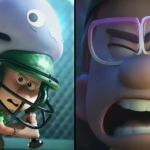An advocate has urged the film industry to stop portraying villains with physical disfigurements.
Disability advocates are calling on the film industry to end the outdated and harmful trope of linking facial disfigurements with villainy, a stereotype frequently seen in franchises like James Bond.
The issue resurfaced with the release of No Time To Die, Daniel Craig’s final outing as James Bond, which includes two villains—Safin (Rami Malek) and Blofeld (Christoph Waltz)—both depicted with prominent facial scars.
This recurring portrayal has been condemned as a “lazy stereotype” by campaigners, including author Jen Campbell, who tweeted: “Every time a new James Bond film is made, the producers are asked to reconsider their representation of disfigurement. Every time, they say they don’t care.”
Campbell underscored the harm caused by these depictions, pointing to the franchise’s long-standing use of scars and visible differences as symbols of evil—such as Javier Bardem’s disfigured jaw in Skyfall and Mads Mikkelsen’s damaged eye in Casino Royale.

Presenter Adam Pearson, who has neurofibromatosis, joined the criticism, emphasizing that these portrayals reinforce damaging stereotypes.
“When the only character with a scar or disfigurement is portrayed as the villain, it perpetuates an outdated and harmful trope,” Pearson said in an interview with ITV News.
Pearson called for more inclusive storytelling, clarifying that the goal is not to “ban baddies from having scars” but to encourage more diverse and nuanced representation of characters with visible differences in film.
The concern goes beyond the James Bond franchise, highlighting a broader issue within the entertainment industry.
From Darth Vader in Star Wars to Scar in The Lion King, Hollywood has a long history of equating physical disfigurement with villainy—a trope that carries significant societal repercussions.
The 2020 adaptation of The Witches, featuring Anne Hathaway as the Grand High Witch, further fueled controversy with its depiction of limb differences, drawing widespread criticism.
Anne Hathaway’s character in The Witches is portrayed with hands resembling ectrodactyly, a condition commonly referred to as “split hand,” characterized by missing or fused fingers.

Critics contended that the film reinforced harmful stereotypes by linking physical differences to villainy, a trope that unfairly stigmatizes individuals with similar conditions in real life.
Advocacy groups, including those representing people with disabilities, expressed outrage over the portrayal, leading both Anne Hathaway and Warner Bros. to issue apologies.
This issue is highlighted in research by Changing Faces, a UK-based charity dedicated to advocating for equal representation of individuals with visible differences.
Their study revealed that nearly 40% of respondents with visible differences had encountered portrayals of people like themselves as villains, while only 20% had seen them depicted as heroes, and just 15% as romantic leads.
In response, Changing Faces launched the I Am Not Your Villain campaign to challenge and counter these harmful stereotypes.
The campaign has gained support from organizations such as the British Film Institute (BFI), which, in 2018, pledged to cease funding films that use scars or facial differences as a marker of evil.

Ben Roberts, Film Fund Director at the BFI, remarked, “It’s astonishing to think that films have used visible difference as a shorthand for villainy so often and for so long. The time has come for this to stop.”
The impact of these stereotypes extends into real life, as individuals with visible differences often report lower confidence, body image struggles, and negative effects on their mental health.
Recognizing the broader implications, Changing Faces stresses the importance of seeing diverse and positive representations in film and television.
Their campaign highlights productions that celebrate inclusivity, such as the BBC adaptation of Malory Towers, which features young actor Beth, and the film Dirty God, starring burns survivor Vicky Knight.
The call for change is clear.
Advocates—ranging from actors and writers to charities—are urging filmmakers to move past outdated tropes and foster a more inclusive and diverse cinematic landscape.
By portraying characters with visible differences as heroes, love interests, and multifaceted individuals—rather than one-dimensional villains—the film industry has an opportunity to promote greater understanding and more meaningful representation.





